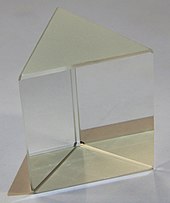Prism (optics)
In optics, a prism is a transparent optical element with flat, polished surfaces that refract light. The exact angles between the surfaces depend on the application. The traditional geometrical shape is that of a triangular prism with a triangular base and rectangular sides, and in colloquial use "prism" usually refers to this type. Some types of optical prism are not in fact in the shape of geometric prisms. Prisms are typically made out of glass, but can be made from any material that is transparent to the wavelengths for which they are designed.
A prism can be used to break light up into its constituent spectral colors (the colors of the rainbow). Prisms can also be used to reflect light, or to split light into components with different polarizations.
How prisms work
Light changes speed as it moves from one medium to another (for example, from air into the glass of the prism). This speed change causes the light to be refracted and to enter the new medium at a different angle (Huygens principle). The degree of bending of the light's path depends on the angle that the incident beam of light makes with the surface, and on the ratio between the refractive indices of the two media (Snell's law). The refractive index of many materials (such as glass) varies with the wavelength or color of the light used, a phenomenon known as dispersion. This causes light of different colors to be refracted differently and to leave the prism at different angles, creating an effect similar to a rainbow. This can be used to separate a beam of white light into its constituent spectrum of colors. Prisms will generally disperse light over a much larger frequency bandwidth than diffraction gratings, making them useful for broad-spectrum spectroscopy. Furthermore, prisms do not suffer from complications arising from overlapping spectral orders, which all gratings have.
Prisms are sometimes used for the internal reflection at the surfaces rather than for dispersion. If light inside the prism hits one of the surfaces at a sufficiently steep angle, total internal reflection occurs and all of the light is reflected. This makes a prism a useful substitute for a mirror in some situations.
Deviation angle and dispersion
Ray angle deviation and dispersion through a prism can be determined by tracing a sample ray through the element and using Snell's law at each interface. The exact expressions for prism deviation and dispersion are complex, but for small angle of incidence θ0 and small angle α they can be approximated to give a simple formula. For the prism shown at right, the indicated angles are given by
 .
.
For a prism in air  . Defining n = n1, the deviation angle δ is given by
. Defining n = n1, the deviation angle δ is given by
 . Defining n = n1, the deviation angle δ is given by
. Defining n = n1, the deviation angle δ is given byThe dispersion δ(λ) is the wavelength-dependent deviation angle of the prism, so that for a thin prism the dispersion is given by
Nicol prism
A Nicol prism is a type of polarizer, an optical device used to generate a beam of polarized light. It was the first type of polarizing prism to be invented, in 1828 by William Nicol (1770–1851) of Edinburgh. It consists of a rhombohedral crystal of calcite (Iceland spar) that has been cut at a 68° angle, split diagonally, and then joined again using Canada balsam (a transparent liquid.)
Unpolarized light enters one end of the crystal and is split into two polarized rays by birefringence. One of these rays (the ordinary or o-ray) experiences a refractive index of no = 1.658 and at the balsam layer (refractive index n = 1.55) undergoes total internal reflection at the interface, and is reflected to the side of the prism. The other ray (the extraordinary or e-ray) experiences a lower refractive index (ne = 1.486), is not reflected at the interface, and leaves through the second half of the prism as plane polarized light.
Nicol prisms were once widely used in microscopy and polarimetry, and the term "crossed Nicols" (abbreviated as XN) is still used to refer to observation of a sample between orthogonally orientated polarizers. In most instruments, however, Nicol prisms have been supplanted by other types of polarizers such as Polaroid sheets and Glan–Thompson prisms.



![\delta (\lambda) \approx [ n (\lambda) - 1 ] \alpha](http://upload.wikimedia.org/math/0/c/e/0cef05c95b70546fb71d5d60c4e1cc3f.png)

